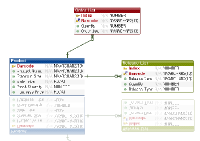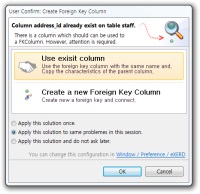Amazing AI
 There
are interesting and surprising AI functions to help users in eXERD™.
It automates the line alignment using Shortest-Path algorithm which is
used in up-to-date games like Starcraft. Besides it always keeps
optimal arrangement of tables based on topology.
There
are interesting and surprising AI functions to help users in eXERD™.
It automates the line alignment using Shortest-Path algorithm which is
used in up-to-date games like Starcraft. Besides it always keeps
optimal arrangement of tables based on topology.
And also, if you change your
documents, eXERD™ calculates the point of changing, provides visual
feedbacks which is the most effective way, and puts user’s focus or
selections on the most suitable location for the next task. eXERD™
makes your work faster by listing items that you have been interested
in recently.
User-Centered Interface
 Whenever you want,
you can change from logical mode to physical mode (and vice versa),
decide everything and decide everything such as order of tables in
their arrangement, whether or not the way to represent them, and so
on. You can even reuse them all.
Whenever you want,
you can change from logical mode to physical mode (and vice versa),
decide everything and decide everything such as order of tables in
their arrangement, whether or not the way to represent them, and so
on. You can even reuse them all.
Individual co-workers can build up their own working environment
according to their preferences.
You don't need to learn to get adjusted to eXERD, because it is
a WYSIWYG editor that has very intuitive appearance and follows the
tradition and UI guidelines of Eclipse.
Beautiful and Interesting Visual Effect
We did it! It is not only beautiful. Cute and animation of eXERD
delivers implicative and intuitive information. For example, doing
Undo/Redo, you can just grasp that a column has been deleted by
destroying animation of column.
Protecting Users From Complicated Environment
 As you know,
ER-Modeling needs a very complicated working environment.
As you know,
ER-Modeling needs a very complicated working environment.
For example, by deleting one of some PK columns, your program
can delete all related FKs or, just invalidate the relations. And,
there can be other aftereffects in chain when deleting the FKs.
In traditional ER-Modeling, one DBA(manually) control,
supervise, and maintain all these situations, and also it consumed
much time and cost. Being Aware of these situations, eXERD™ provides
visual guide to the users regarding with how to deal with the
problems, clarifies the user’s intention and executes it, so as to
protect the user from making unexpected mistakes.
 There
are interesting and surprising AI functions to help users in eXERD™.
It automates the line alignment using Shortest-Path algorithm which is
used in up-to-date games like Starcraft. Besides it always keeps
optimal arrangement of tables based on topology.
There
are interesting and surprising AI functions to help users in eXERD™.
It automates the line alignment using Shortest-Path algorithm which is
used in up-to-date games like Starcraft. Besides it always keeps
optimal arrangement of tables based on topology.
 Whenever you want,
you can change from logical mode to physical mode (and vice versa),
decide everything and decide everything such as order of tables in
their arrangement, whether or not the way to represent them, and so
on. You can even reuse them all.
Whenever you want,
you can change from logical mode to physical mode (and vice versa),
decide everything and decide everything such as order of tables in
their arrangement, whether or not the way to represent them, and so
on. You can even reuse them all.
 As you know,
ER-Modeling needs a very complicated working environment.
As you know,
ER-Modeling needs a very complicated working environment.